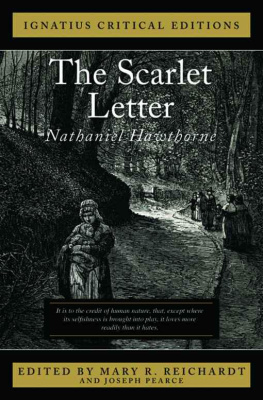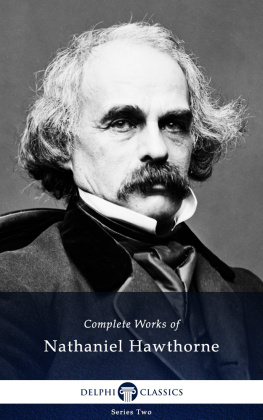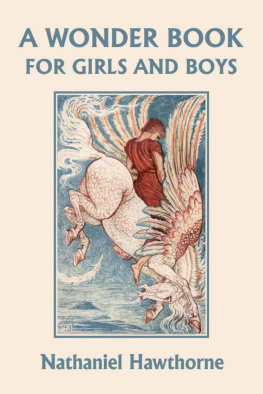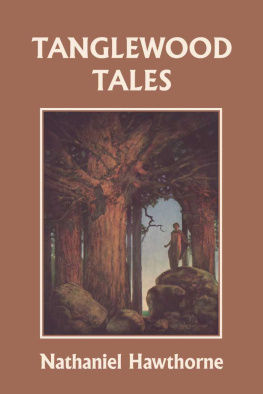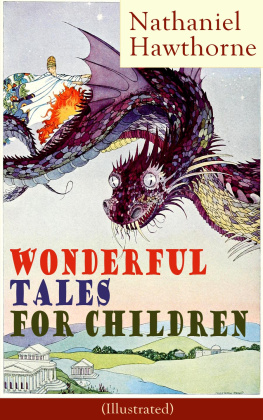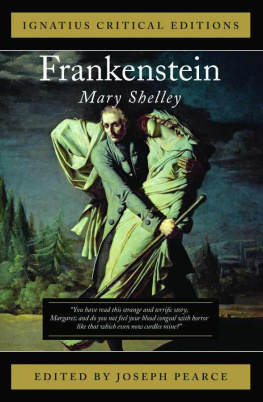THE SCARLET LETTER
NATHANIEL HAWTHORNE
THE SCARLET LETTER
With an Introduction
and Contemporary Criticism
Edited by MARY R. REICHARDT
Ignatius Critical Editions Editor
JOSEPH PEARCE
IGNATIUS PRESS SAN FRANCISCO
Cover art: Illustration by Mary Hallock Foote from the 1878 edition
published by James R. Osgood and Company, Boston
Cover design by John Herreid
2009 Ignatius Press, San Francisco
All rights reserved
ISBN 978-1-58617-281-7
Library of Congress Control Number 2008933488
Printed in the United States of America
Tradition is the extension of Democracy through time; it is the proxy of the dead and the enfranchisement of the unborn.
Tradition may be defined as the extension of the franchise. Tradition means giving votes to the most obscure of all classes, our ancestors. It is the democracy of the dead. Tradition refuses to submit to the small and arrogant oligarchy of those who merely happen to be walking about. All democrats object to men being disqualified by the accident of birth; tradition objects to their being disqualified by the accident of death. Democracy tells us not to neglect a good mans opinion, even if he is our groom; tradition asks us not to neglect a good mans opinion, even if he is our father. I, at any rate, cannot separate the two ideas of democracy and tradition .
G.K. Chesterton
Ignatius Critical EditionsTradition-Oriented Criticism for a new generation
CONTENTS
Hawthorne on the Human Heart: Symbolism in The Scarlet Letter
Jennifer Bonsell
Pearl and Penance
Richard Harp
The Scarlet Letter: Sin, Suffering, and Salvation in a Fallen World
Regis Martin
INTRODUCTION
Aaron Urbanczyk
Southern Catholic College
The Scarlet Letter is one of American literatures greatest tragedies. In chapter 1, Nathaniel Hawthorne refers to his work as a tale of human frailty and sorrow,
The Scarlet Letter mines New Englands history to create a uniquely American tragic idiom, and it is also a novel born of Hawthornes complex reaction to his own Puritan heritage. The Scarlet Letter is as personal a work of fiction as Hawthorne ever wrote. His sense of himself, his past, and his understanding of literature pervade the novel. Indeed, history in The Scarlet Letter plays a heavy, perhaps even oppressive, role. Thus it is important to understand Hawthornes life, the circumstances under which he wrote the story, and his Puritan ancestry to properly appreciate the tragic brilliance of his greatest literary achievement.
Nathaniel Hawthorne was born on July 4, 1804, in Salem, Massachusetts, and he died in his sleep on the evening of May 18 (or the early hours of May 19), 1864, in Plymouth, New Hampshire. He descended from a long line of New England Puritans and sea captains on his fathers side and industrious Yankee businessmen on his mothers side. His father, Captain Nathaniel Hathorne, was involved in the Oriental sea trade that made Salem wealthy during the late eighteenth century. As a young boy, Nathaniel read his fathers sea journals. This connection to his father was important to him because Captain Hathorne died at sea in 1808, before Nathaniels fourth birthday. Nathaniel thus grew up closer to his mothers family, the Mannings, mostly thrifty business folk who took the trouble to educate him. He graduated from Bowdoin College in Maine in 1825 (where Henry Wadsworth Longfellow and future president of the United States Franklin Pierce were his classmates) and, like all college graduates, felt pressured to choose an occupation. Absent a father and feeling the expectations of his Manning relatives, Hawthorne selected an unlikely profession: he became an author of fiction.
Hawthorne returned to Salem and embarked upon a period of secluded literary apprenticeship and productivity lasting from 1825 to 1837. Prior to 1836, Hawthorne devoted himself almost exclusively to writing. During this time, he published a novel and numerous short stories, with only limited commercial and literary success. In these years, Hawthorne also began seriously researching colonial Puritan history, his Hathorne ancestors particularly. Clearly he was less than enthusiastic over what he discovered of his grave Puritan forefathers. He added the w to his last name sometime around 1830, a move that may have been motivated, one might speculate, by a desire to distance himself from several of his infamous paternal ancestors. Between 1836 and 1846, he attempted to support himself by editing a magazine in Boston (January-August 1836); serving as measurer of coal and salt at the Boston Custom House (1839-1840); participating in George Ripleys utopian scheme for communal living, Brook Farm, in West Roxbury, Massachusetts (April-November 1841); and continuing to write short stories, after his marriage to Sophia Peabody, in a cottage on the property of Ralph Waldo Emersons family in Concord, Massachusetts, called the Old Manse (1842-1845). A faithful Democrat, he actively cultivated and retained the friendship of many New England Democrats though his interests were more literary than political. As a result of such solicitous friends, he was appointed chief officer of the Salem Custom House, a position he occupied from April 1846 until June 1849. Realizing that fiction writing was not the most stable occupation for a family man, Hawthorne gladly accepted a government job with a steady income. But in the nineteenth century as today, any job associated with political partisanship is uncertain, and he was unceremoniously fired from the Salem Custom House in 1849. A member of the opposing political party, the Whig Zachary Taylor, won the 1848 presidential election, setting in motion a movement to excise members of the losing political party, the Democrats, from federal offices in New England. As Hawthorne poetically ruminates in The Custom-House, his introductory section to The Scarlet Letter , my own head was the first that fell in the political guillotines at work under the new Whig administration (see p. 43).
In many instances, it is not necessary to place a literary work in the context of the authors life to appreciate its aesthetic merit. In the case of The Scarlet Letter , however, Hawthorne very personally introduces the novel through the lens of tragic events in his life, both the tragedy of losing his livelihood as a federal employee and the tragedy of being a descendant of his Hathorne ancestors. Upon being fired, he found himself once again a literary man reliant upon his pen for income, and he set to work furiously on the manuscript that became The Scarlet Letter . Initially, Hawthorne conceived of The Scarlet Letter as one story in a collection of tales (as noted in his mention in The Custom-House of other tales in the volume). His publisher James T. Fields, however, suggested Hawthorne present just Hester Prynnes story with the introductory sketch, The Custom-House.
The Custom-House sketch not only is important regarding literary biography but also guides the reader in understanding The Scarlet Letter as a literary work of art. Several themes in this piece immediately urge themselves upon the reader. Ostensibly it provides a vivid image of the authors workplace during his tenure at the Salem Custom House. Yet upon closer inspection, The Custom-House does much more than merely regale the reader with humorous details of the authors co-workers. For one thing, it underscores Hawthornes fatalistic sense of place by meditating upon his attachment to Salemor perhaps better said, upon Salems claim on him. In The Custom-House, the narrator views Salem as a place of tragedy, and this sense of place is mirrored in the novel proper. Because of the long connection of [his] family with one spot, Hawthorne states, I felt it almost as a destiny to make Salem my home (see p. 12). This theme is echoed in Hester Prynnes decision to remain in Boston after the sentence of the scarlet letter (signifying adultery) is imposed upon her. As the narrator of The Scarlet Letter tells us,
Next page
